The principle of the video projector
The projector is a device that connects to a video camera, laptop, PC, or tablet, in order to display the picture on the big screen. To control the operating device is used remote control. The device of the video projector is quite complex, and may have differences depending on the technology used to compose the image. The technology depends on how the projector will work. At present, 5 technological advances are used in video projector equipment:CRT, LCD, D-ILA, DLP laser technology.
Content
CRT technology
This technology can be considered the oldest, as the basis for it is taken cathode-ray tube (CRT). Although the CRT-technology has been used for several decades, nevertheless,it is still relevant and in terms of the quality characteristics of a picture (clarity, resolution, color rendition) is not inferior to modern and more expensive methods of image formation. Another advantage of the CRT is the high reliability of the electrical circuit and the duration of the continuous operation of the tube, exceeding the limit of 10,000 hours.
Also, this technology has a wide dynamic brightness range and black depth, which can not provide any other.
Despite the undoubted advantages, CRT-devices are still inferior in some indicators to modern devices.
- Aggregates have large mass (several tens of kilograms). Make the manufacturer a little easier, would be the possibility of more convenient transportation and installation of this equipment.

- Brightness level is in the range from 100 to 300 ANSI-lm, while in modern devices the level can reach 10,000 ANSI-lm and more. For this reason, watching a video is only possible in a well-darkened room.
- In order to achieve a good image quality, it is required to make a lot of adjustments, and sometimes it is difficult to do without the involvement of a specialist.
CRT Projector
Inside a CRT video projector, there are 3 CRTs with screens ranging from 7 to 9 inches. Each CRT is designed to display one color (green, red, blue) of the RGB color model.
The principle of operation of the projector can be described as follows: the input signal is divided into components by color, which are involved in the control of modulators. In this case, the intensity of the beam begins to change. At this moment, the beam, passing through a magnetic field and deflecting system, exposes the surface of the screen with the applied phosphor coating scan from inside. After that, a monochrome picture is created on the screen. Further, through the lens, it is projected onto the outer screen.

As a result, 3 images are projected on the external screen at the same time, and when mixed, a full-color picture is obtained.
Advantages of CRT devices:
- The output image is high enough;
- long period of operation;
- passive cooling;
- unlimited resolution;
- low noise level;
- high contrast;
- technology that has passed the test of time (more than 50 years).
Disadvantages of CRT devices:
- the need for periodic adjustment (calibration);
- geometry fuzziness;
- low level of brightness;
- it is desirable not to apply, to project a static image.
LCD technology
In LCD projectors, for example, in the devices of the company Viewsonic (Vyusonik), to create images used luminal matrix. It can be compared to the work of an overhead projector. But the difference is that the light does not pass through the slide, but through the panel with liquid crystals. It consists of a large number of pixels, which are elements that can be controlled by an electric signal. The magnitude of the voltage applied to a particular pixel depends on its transparency and, accordingly, the intensity of brightness on the screen at the point of projection of this pixel.
Thanks to LCD technology, steel projection units much cheaper. They became more compact, and the power of light radiation began to reach 10,000 ANSI-lm. LCD technology is best adapted for reproducing a digital signal from a PC and other devices.
Viewsonic LCD devices are very easy to set up, easy to use, and all settings are saved after dismantling and transportation. For this reason, they are often used to design business presentations.
The device of the LCD unit
In LCD projectors, to form an image, are used liquid crystal panels. The technology uses the ability of molecules of a certain substance to change its orientation in space under the action of an electrical impulse.
In modern devices began to use 3 matrices of liquid crystals made of polysilicone. Their size is diagonally from 0.7 to 1.8 inches. The figure below shows a structural diagram of a video projector.

The light that a lamp emits when passing through dichroic mirrors is divided into 3 components of the RGB color model. Further, each component must pass through the corresponding LCD panel. It creates an image related to this color layer. When the formation of images in the LCD panels is completed, they, passing through the prism, overlap each other, and the full-color picture is displayed on the screen through the optical lens.
In the figure below you can see how the projector is arranged.

LCD advantages:
- affordable price;
- small weight;
- an indispensable thing for presentations;
- can be used for screens with a large diagonal;
- the picture has perfect geometry;
- simple settings and operation.
- high brightness;
Disadvantages:
- expensive lamp;
- low contrast;
- the matrix has a tendency to degrade (grow old) over time — typically, 3-4 years of use are sufficient;
- dead pixels may appear;
- due to the use of cooling fans, a noticeable noise of the unit.
D-ILA Projector
Huges-JVCT has recently developed D-ILA technology. It can be considered an embodiment of the LCOS technology, which represents the most promising topic for the improvement of projection units.
As with LCD, D-ILA uses liquid crystal elements, but instead of matrices of an enlightened type, reflective elements. Such devices have a difference: the light-modulating layer is arranged in such a way that it is located on top of the substrate consisting of monocrystalline silicon. In the substrate is the entire circuit that is used to control the matrix. This fact has a distinct advantage over LCD panels.
D-ILA-matrix can, when compared with the LCD, at a much higher resolution, given the fact that their sizes are smaller. Also, in the new matrices, the area of the crystal used is involved in 93%, which excludes the appearance of a grid when a picture is displayed.The technological process of manufacturing D-ILA-matrix is much easier than the production of LCD.
D-ILA Device
D-ILA devices, as well as LCD, are created by three-matrix principle. Matrices separately create pictures of three colors. After that, the generated image enters the wall screen through the lens.
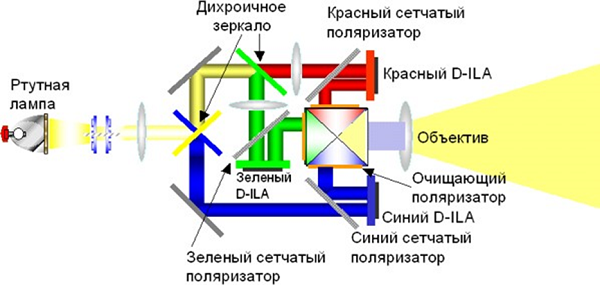
Benefits:
- use for presentations;
- high brightness;
- possibility of use for large projection screens;
- perfect picture geometry;
- a light weight.
Disadvantages:
- the possibility of "broken" pixels;
- due to the novelty of technology, there is no data on the service life of the matrix;
- expensive light source.
DLP projector
The matrix of this projector is called a DMD chip and is manufactured in America by Texas Instruments. How does the projector work? There are millions in the matrix mirror elementsthat have the ability to rotate at the right angle. When turning, the mirror can take only 2 fixed positions.
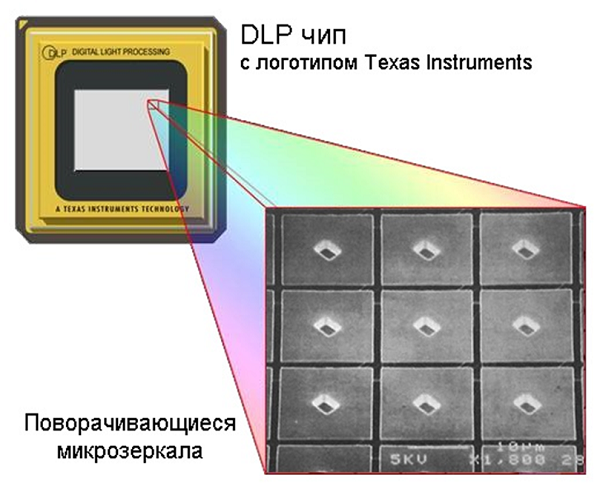
Therefore, the mirror reflects the light on the screen or in the direction of the light absorber (radiator) of the device, producing a black or white point.

When you repeatedly switch from white to black, you get halftones of gray.

One Matrix Apparatus capable of outputting only one color component of the image at each moment of the time interval.

To separate other colors from white and black, use a color disk (a disk having light filters).

The speed of rotation of the disk with light filters may be different. The faster the wheel spins, the less will occur. ”rainbow effect”Inherent in one-matrix devices. The wheel with light filters can consist not only of traditional RGB segments (red, green, blue), but also be supplemented with additional colors. For example, the figure below shows a color wheel, which is a combination of two color schemes RGBCMY (Red, Green, Blue, Cyan, Magenta, Yellow).

What constitutes an optical unit of a DLP apparatus is clearly seen in the following figure.

The color wheel also has a transparent element for passing pure white color, which enhances the black and white brightness of the image.

This will solve the problem of the inefficiency of one-matrix technology, as a result of which the installation of a more powerful light source is not required.
One of the first representatives of the DLP projectors was the Viewsonic PJD5126.
Property high brightness black and white pictures became useful for devices that are widely used in offices. The black and white image is noticeably higher in brightness than the colored components. Although, if you set the maximum brightness level, the colors may become dimmer. Fading colors are not common to all DLP units, since most manufacturers strive to improve the quality of their products.
Three Matrix DLP Projector
Also exist three-matrix projection apparatus, with the division of the luminous flux on the traditional RGB. When this occurs, three images of different colors are projected onto the external screen, as a result of which a full-color picture is formed.
DLP devices have a high level of brightness, which can reach 18,000 ANSI-lm.
Benefits:
- small weight;
- correct geometry;
- durability of the matrix;
- used for large screens;
- low noise;
- high brightness
Disadvantages:
- in the case of one-matrix construction, the “rainbow effect” is noticeable in the picture;
- expensive lamp;
- "defective pixels.
Laser technology
The most advanced and most expensive technology for the formation of the highest quality image is a laser. Representative of a new type of projection equipment can be called a ViewSonic LS830.
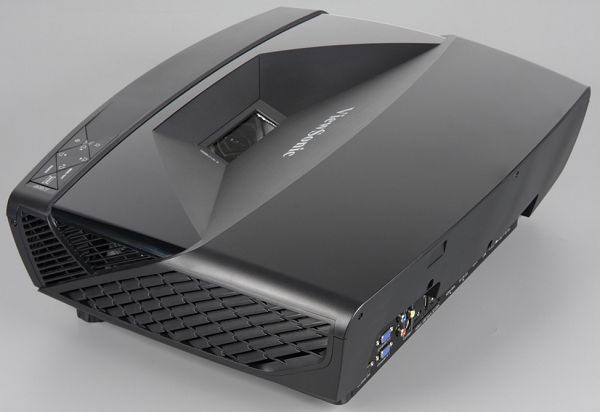
The principle of operation of the unit is the same as in the models discussed above: with the help of a laser, 3 color components are formed, which, ultimately, are mixed. Further, through a complex system, including focusing and scanning, an image is created using a system of mirrors. It is possible to form an image on almost any surface, including uneven.
The total cost of operation is greatly reduced by the use of laser technology, since the laser can be considered conditionally eternal. The estimated period of his work is 20 000 hours, not requiring special maintenance. In this case, the device will produce an excellent brightness, not decreasing over time. Throughout the years of operation of the equipment, the picture quality will remain at a high level. The brightness level in the Viewsonic is high enough - 4,500 lumens, which is suitable for watching videos in a well-lit room.
Almost all modern laser projectors have ultrashort focus lenses (0.23). This allows the projector to be positioned at a distance of 21 cm from the screen, which makes it almost imperceptible.
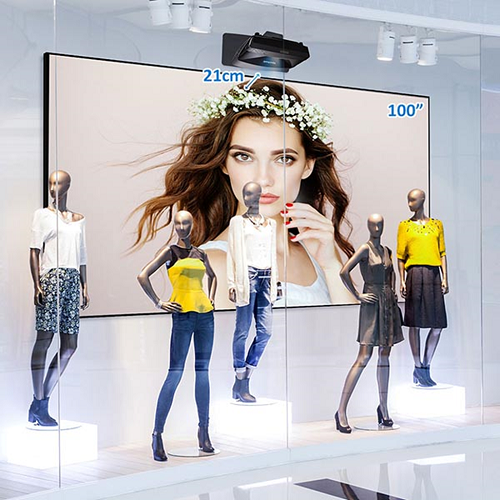
In the figure below, the projectors are located at a distance of 17 cm from the wall.

Laser technology is capable of producing colors with great depth and saturation, with high brightness and detail, as well as with a wide color gamut. Due to the high contrast (100 000: 1), the picture is notable for perfect sharpness and smooth transitions of semitones.

Also, the use of laser technology makes it possible to project a color image. Full 1080p HD resolution practically no deformation.
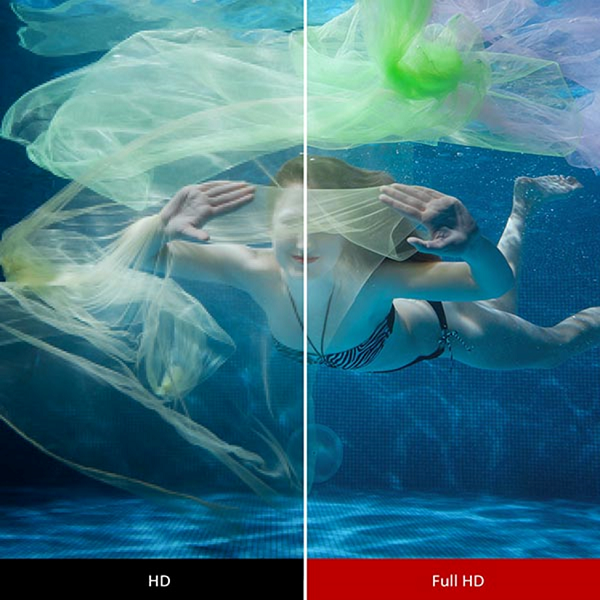
One of the most important advantages of laser video projectors is the ability to project a picture on huge screen sizes.
Thus, in the market of video projectors there are a considerable number of models, both expensive and budget. They differ mainly in technologies that are used for imaging, and, accordingly, in price. The more advanced technology, the higher the price of the device.

/rating_off.png)











